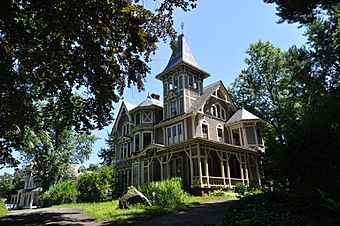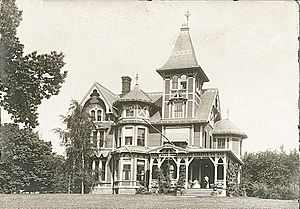Dr. Mary B. Moody House facts for kids
Quick facts for kids |
|
|
Dr. Mary B. Moody House
|
|
 |
|
| Location | 154 E. Grand Ave., New Haven, Connecticut |
|---|---|
| Area | 2.4 acres (0.97 ha) |
| Built | 1875 |
| Architectural style | Carpenter Gothic |
| NRHP reference No. | 100000930 |
| Added to NRHP | May 1, 2017 |
The Dr. Mary B. Moody House, also known as Chetstone, is a special old house in New Haven, Connecticut. It was built in 1875 and is a great example of a building style called Carpenter Gothic. This house was once home to Dr. Mary Blair Moody, who was one of the very first female doctors in New Haven. Because of its history and unique design, the house was added to the National Register of Historic Places in 2017.
Discovering the Dr. Mary B. Moody House
The Dr. Mary B. Moody House is in a part of New Haven called Fair Haven Heights. It sits on a hill, looking out over the area. The house is made of wood and has a very interesting, detailed look. It has a tall, three-story tower with a cool pointed roof. There's also a big porch that wraps around the front and one side of the house. You can see fancy wooden decorations on the gables (the triangular parts of the roof) and some windows have a slightly pointed shape. This style is part of what makes it a great example of Carpenter Gothic architecture.
Who Was Dr. Mary B. Moody?
The house was built in 1875. Dr. Mary Blair Moody and her husband, Lucius Moody, lived here from the 1880s into the early 1900s. Lucius worked in insurance, but Mary had a very different career for her time. She was the first woman to attend the University of Buffalo Medical School, graduating in 1876.
Even though it was unusual for women to be doctors back then, Dr. Mary Moody chose to practice medicine while also raising her family. She became one of the first female doctors in New Haven, helping many people in her community. Her story shows how determined and pioneering she was.
Saving a Historic Home
In 2012, the Dr. Mary B. Moody House was damaged by Hurricane Sandy. Strong winds caused problems for the roof and gutters. Luckily, a special grant of $150,000 was given to help fix the house. This money made sure that this important historic home could be repaired and continue to stand for future generations to learn from and enjoy.




